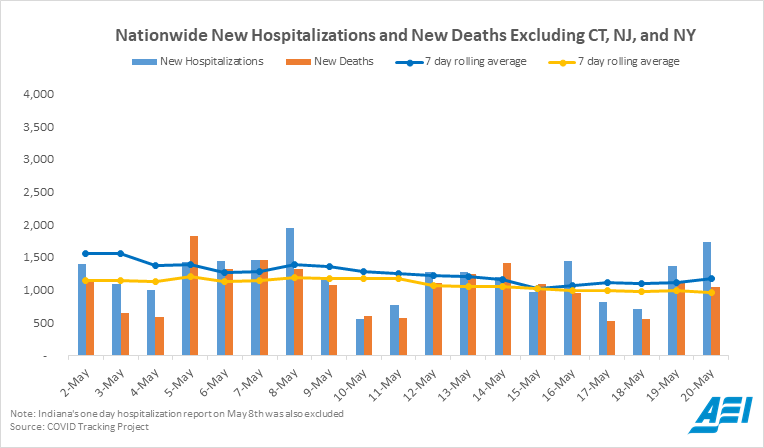Week in Washington is brought to you by Michael Cohen, PhD. Tune in each week to read the latest on healthcare policy and get a glimpse of what’s on the horizon.
Week in Washington
5/21/2020
Overall COVID Picture

Overall this week, the rate of COVID related hospitalizations and deaths were generally flat or slightly higher relative to the previous few weeks. When controlling for the improving situation in New York (and surrounding areas), it does appear there has been an uptick in hospitalizations in the rest of the country, relative to last week.
One key issue to flag is how regionalized the outbreak has become. Some states have made dramatic improvements (i.e., New York) other areas have not. Even within states, there is marked differences. For example, while overall Alabama’s numbers have not been bad, the situation in Montgomery, Alabama has become dire, with ICU’s full.
Testing numbers – One emerging problem in identifying exactly the severity of the outbreak has been gaps in data. Recently, it’s been revealed that some states and the CDC have been combining diagnosis testing and antibody testing results into higher testing numbers. Furthermore, not every state releases hospitalization data. The result is that those using COVID testing data should understand their limitations.
Latest Research on Drivers
There has been a spat of articles on potential drivers for influencers of COVID spread at the community level. A few worth highlighting:
- Weather – Harvard researchers have found some evidence that hotter weather does inhibit the spread of COVID. This would point to the potential for seasonality to the virus.
- Social Distancing – There is growing evidence that social distancing also decreases spread. It’s important to note that, at least currently, state policies and the amount of social distancing individuals are doing are not strongly correlated. While there’s not a great single source for measuring single distancing, I’d recommend this google data link.
- Stochastic Factors – Finally, it’s important to note that there’s a bit of randomness in the data currently. Small chance events could make larger impacts than can be measured. For example, there’s emerging research that the timing of when universities’ spring breaks were held, impacted a community’s rate of COVID related infections/deaths. Universities that had spring break earlier, i.e., students flying to places with the virus and then bringing it back, had a negative impact on their community. That said, it may be difficult to exactly capture this kind of impact, a priori.
Deferred Care
There has been a spat of newly released data on deferred care. A few useful links:
- Commonwealth (outpatient data)
- Strata (facility)
- State Level Survey Data on delayed medical care
Previous editions:
5/14/2020: Week in Washington
5/7/2020: Week in Washington
4/30/2020: News on the Last Week in April
4/23/2020: Week in Washington
4/16/2020: Waiting on Congress
4/9/2020: Week in Washington
4/2/2020: Grim News
3/26/2020: Latest on COVID-19